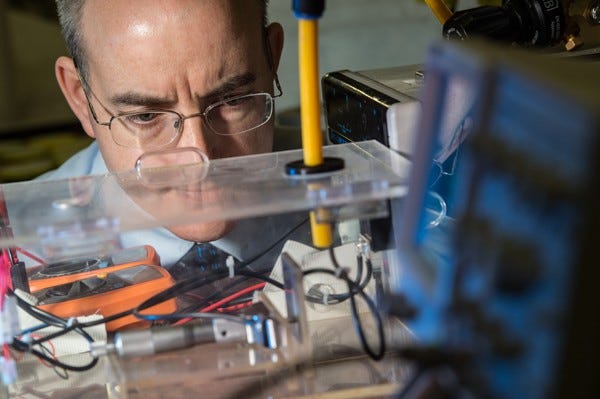Why are academics so bad at tech transfer?

I’m very fortunate in that my foray into private enterprise has been (so far) very successful: well-selling product lines, an engineering design office fizzing with good ideas, and a healthy, sustainable re-investment back into the fundamental research that gave birth to the company in the first place.
It’s only recently come to my attention that my experience is something of an aberration: overwhelmingly, when academics try to commercialize their ideas, the results are catastrophic- so catastrophic, in fact, that they have inspired their own stand-up comedy act. It wasn’t immediately clear to me what I had done right: with no prior experience in business management and no background in product development, why had I not failed as so many of my colleagues in academia had?
With this question in mind, I started poking around, and examined some of the failed ideas and spin-outs piled in the academic dustbins. Specifically, I was interested in what was different between these initiatives and my own- for no other reason, really, than to be able to pinpoint what I’ve done right. Some of the results were obvious- others were surprising.
1. Be careful if your business idea is an answer looking for a question.
When you’ve got a solution available to someone else’s problems, it can still be quite difficult to convince them it’s worth investment: the difficulty increases by an order of magnitude if you also have to convince them that they’ve got a problem in the first place. “Selling” ideas is very hard work.
As academics, we absorb ourselves in our niche areas of expertise. When you are so committed to a particular technology, you are going to see all sorts of potential applications for it. Part of our job is to dream up fantastical panacea end-uses for the consumption of grant funding panels (usually consisting of other like-minded academics). We usually end up asking ourselves the question, “how can I shoe-horn this fundamental science into a plausible real-world technological application so that I can get funding to continue my research”?
Yes, if you’ve got a great idea and it would significantly improve the way things are done, it will eventually get noticed- but there’s a lot of momentum in these things. The challenge is best summarized by what the CEO of a company manufacturing specialized widgets once said to me: “I agree- your technology is a lot better than ours. But we’re still managing to shift twenty million worth of ours a year- so we’re doing just fine as we are, thanks.”
The difference: we didn’t initially set out to form a spin-out company. People from other universities and businesses had heard (through networks and our publications) of the work we were doing, and had approached us asking for our technology. We only formed the spin-out company when this side-hustle started to overwhelm us.
2. Scientists tend to be really lousy at business. Get help.
Like me, many career scientists have never set foot outside of academia. Running a business is a specialist skill- but many scientists tend to dismiss this as “trivial”. It is not.
A business is about much more than finding a legal way to profit from the ideas your work has generated. It’s about filing formal Confirmation Statements. It’s about VAT exemptions. It’s about HS codes for export, ITAR and end-user certificates for dual-use technology. It’s about staff ACAS-managed grievances and NI contributions withheld from source. It’s about commercial lease agreements and limited third-party product liability insurance. If, like me, you never even heard of some of these terms, then chances are you will not be able to run a tech business — and, if you do, you will struggle to grow the business beyond a one-person side-hustle.
Even if just pitching for venture capital, you need to be able to present a viable, sensible business plan. Career scientists tend to be quite bad at doing this. The only experience we have, again, tends to be from preparing grant applications: the judging criteria are set by legislators, but the bids are written by academics, and are assessed by academics. Most grants therefore require some sort of ‘management plan’- but these are largely just dismissed as ‘yet more meaningless middle-management waffle’ by both applicants and panels. On the other hand, to someone looking to invest in a business, it’s the other way around: your business plan is of primary importance, and there are some expectations and conventions about these of which scientists may be entirely ignorant.
The difference: our company formed as a partnership between two scientists (the idea generators) and two business specialists (the implementors). This symbiosis has been absolutely critical, as we (the scientists) can concentrate on spending our limited time on what we do that’s most valuable (developing new technology) rather than struggling to do what others could do better.
3. Embrace failure.
Because of the extreme specialization that we tend to have these days, scientists tend to narrow their professional focus and become experts in highly specific areas (in medicine, these specialists are sometimes jokingly referred to as “left-ear surgeons”). If your area of specialization lends itself to one and only one product- and this product fails to gain any traction- you can keep hammering — but it much easier to turn the page, admit your “pet technology” isn’t going to make it, and move on to something else that could be more successful.
As scientists and academics, we tend to be pathologically rational. If we have a better technology, or an optimal solution, we have trouble understanding why the world isn’t beating a path to our door. Sometimes good ideas are just squibs. As academics, we are used to failure and rejection (grant success rates these days can be in the single-digit percents): however, our usual approach to a failed grant application is very practical. We just reheat the same ideas and send them off to a different funding agency: after all, grant success is just fifty percent dumb luck, and fifty percent being able to prove that you’re the best (or only) left-ear surgeon in the world. This won’t work when trying to commercialize technology.
The difference: our first flagship product failed. Miserably. Expensively. Patentedly. A fantastic technology, a definite need in the market, customers lined up and everything — it just didn’t get enough traction against well-entrenched competitors. Rather than focusing our resources on trying to ram that product into the market, we just left it- wrote off the investment, and moved on to the next project (which turned out to be our best-selling product to date).
4. Be lucky.
This is sad, but true. You can have the greatest idea that ever was; you can have the backing, the team, the expertise and everything else- but there will always be an element of dumb luck over which you have no control.
Recessions happen. Worldwide component shortages happen. “Black swan” events will happen. Bad things happen to good products.
The difference: we were lucky. It took a while to find our stride, but we were able to do so in a time of reasonable stability and prosperity, and will weather the next storm when it hits. We were able to recruit some very good people. We’ve had amazing suppliers and subcontractors, and had some great customers willing to take a risk awarding major contracts to a relatively new player. These are things for which you just can’t plan. No matter how robust your contingency management, things could always get worse. You will always need a bit of luck.
If you’re an academic and are considering expanding your enterprise side-hustle, go for it: it’s rewarding, incredibly instructional and will open to you a whole new world outside of the research lab. Give yourself every chance to succeed- and just be aware of the particular risks the world of enterprise holds for career academics.
Published on LinkedIn by David Birch, Director of Research, Surrey Sensors Ltd. and Senior Lecturer, University of Surry


